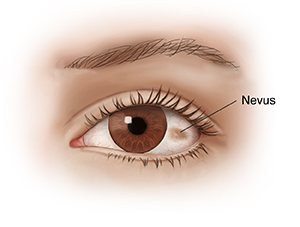A nevus is a colored growth on your eye. It’s much like a mole on your skin. It's sometimes called an eye freckle.
Nevi are common. They are rarely cancer. But in some cases, they can turn into melanoma, a type of cancer.
What causes a nevus?
A nevus can occur when cells called melanocytes clump together in your eye. These cells are normally spread out. They make a pigment called melanin. This pigment gives your eyes, skin, and hair their color.
Being exposed to ultraviolet (UV) light may raise your risk of developing a nevus. You can lower that risk by wearing sunglasses that absorb at least 99% of UV rays. Sometimes nevi run in families.
Symptoms of a nevus
A nevus often appears as a dark-colored spot on the eye. It may be brown or yellow in color. It can grow on different parts of the eye, including the:
-
Clear membrane that covers the eye (conjunctiva)
-
Colored part of the eye (iris)
Some nevi grow inside the eye on the choroid. This is a layer of tissue under the retina. These growths are called choroidal nevi. They can be seen only by an eye care provider during an eye exam. They may appear yellow or brown, or other colors.
Treatment for a nevus
Most nevi don’t need treatment. But there is a chance a nevus, especially one inside the eye, can turn into melanoma. For this reason, your eye care provider will likely watch the nevus over time for changes. You may need regular eye exams.
Your eye care provider may also use an imaging test called optical coherence tomography. This test uses light waves to make detailed images of the retina and helps determine if the nevus has changed in size or shape.
If the nevus becomes cancer, you will need treatment. Your eye care provider may advise surgery, radiation, or laser therapy. In some cases, the side effects of cancer treatment may cause more problems. Your eye care provider may then choose to wait and watch to see if the nevus gets worse.
When to call your healthcare provider
Call your eye care provider right away if:
-
The nevus changes in color or shape
-
You feel eye pain
-
You start to have problems with your vision, such as flashing lights
-
You notice a new spot on your eye


